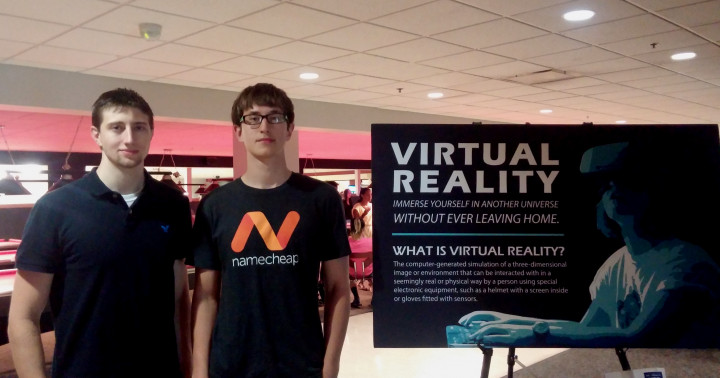Galen Stetsyuk and Mikhail Sorokin Develop and Exhibit Virtual Reality Game
Undergraduate students Galen Stetsyuk and Mikhail Sorokin, in conjunction with the Virtual Reality (VR) Club, have developed a tank game named Core Disruption for the Oculus Rift to inspire general interest in VR. A demonstration of the game will be available in TerpZone in the Stamp Student Union during the first week of school.
In the hope of learning more about the project—and with the nebulous goal of not getting motion sickness—I stopped by the CS Undergraduate Project Room in AV Williams in mid-August to meet with Stetsyuk and Sorokin.
Both developers are sophomores majoring in Computer Science. “We met each other at a gym,” says Stetsyuk. Working together at VTHacks in February using an Oculus Rift provided by UMD's Computer Science Department spurred the two's development of a motorcycle simulation, which gradually led to the idea for a tank demonstration. A motorcycle's faster movement leaves less room for imprecise physics, the students mention: navigating from inside a slower-moving tank drastically reduces the potential for players getting motion sickness.
The game is being developed in the Unity game engine, and can be controlled with an Xbox controller. Players can turn their head to look through “windows” within the tank: it feels very immersive, even on the first time trying it out.
Stetsyuk and Sorokin have added a cooperative (co-op) mode, in which one player drives the tank and another player controls the tank's guns. When visiting in August I was able to play (albeit while floundering hopelessly around the map) a version with both controls available. Even with my less-than-proficient driving skills, it was evident how much detail had gone into the game's experience. The students created models of the game's tanks from scratch, in addition to recording many of the game's sounds: one of the idling noises, Galen explains, came from running his motorcycle's exhaust sound through a filter.
The developers explain that the co-op mode is designed to encourage cooperation between the players as well as looking around the tank: “Many Oculus Rift games right now … don't get you fully immersed,” Stetsyuk elaborates. “It's just the Oculus Rift on your head and you can look all around, but—”
“Yeah, there's a lot of gimmicks,” Sorokin continues: “more than an actual simulation of being there.”
The students' game, however, feels realistic. One of the first things I noticed was that I could look around both the inside and outside of the vehicle: coupled with the background sounds and fluid controls, it felt like I was really inside a tank.
“We have someone set up as if they're already in the seat,” notes Stetsyuk: “they're looking around, they have these views … it's almost as if they're actually there.”
Making Computer Science students more aware of VR technology is important, Stetsyuk and Sorokin say, but just as essential is generating awareness for other students in the university. “We want this to be an introduction to those who haven't used the Rift before, or for those who have used the Rift to have a new way of being immersed,” Stetsyuk notes.
There's a lot of future options available, the students say. In spite of the hard work undertaken on the project thus far—Stetsyuk points to a pile of bedsheets and pillows on one side of the project room, mentioning casually that “I only had to sleep here once”—the developers are both eager to continue working with Virtual Reality technology. “We want to get it to the point where it's a pretty capable tech demo,” Sorokin remarks: “A full game we may explore later depending on if our interests stay with it, or if we think there's a better application … we can start over with all the things that we learned working on this one.”
They're planning to start a company, Sorokin says: “We're going to be starting with games, but there are lots of applications for VR.” He lists military simulations and healthcare applications as just a few of the technology's potential uses.
As mentioned, the game will be playable by anyone in TerpZone from 5 to 7 PM during the first week of school. The last day of the demonstration will be Saturday, September 5. In addition to the Rift's head-mounted display, a designated television set will be set up to stream what the players looking through the Rift are seeing.
“Around the time when [Mikhail and I] decided we were going to go to a hackathon, we actually had Oculus VR come in and make that big donation for the new building and have all the equipment set up … we thought this was a perfect opportunity for us to take some of the equipment that has been generously donated to the University for students like us to develop on, and—we, uh, we pounced on it,” Stetsyuk reminisces, smiling: “That's how we got into VR.”
The Department welcomes comments, suggestions and corrections. Send email to editor [-at-] cs [dot] umd [dot] edu.
